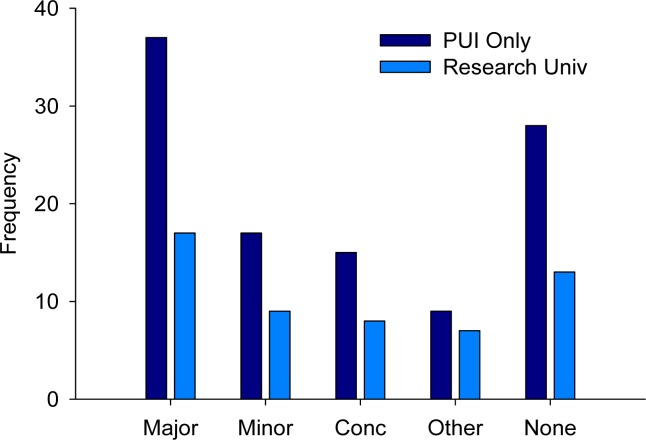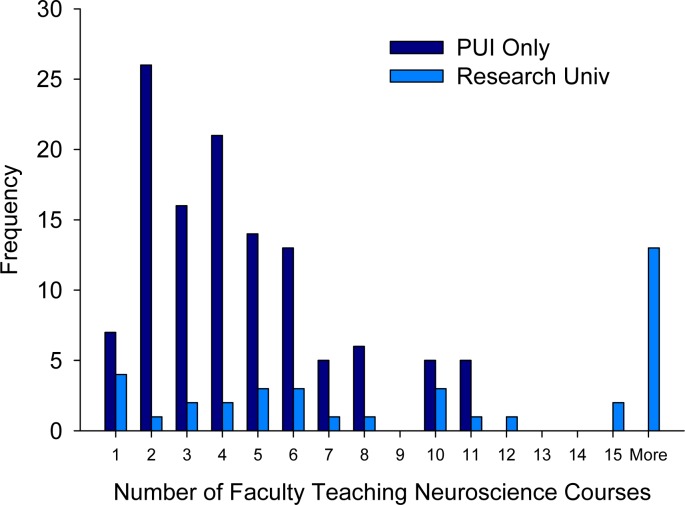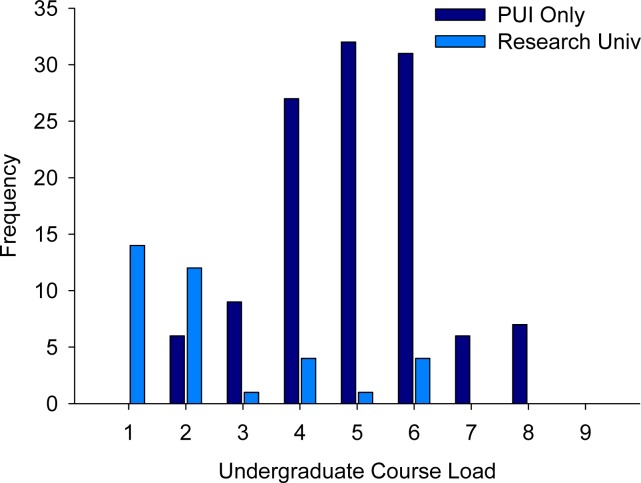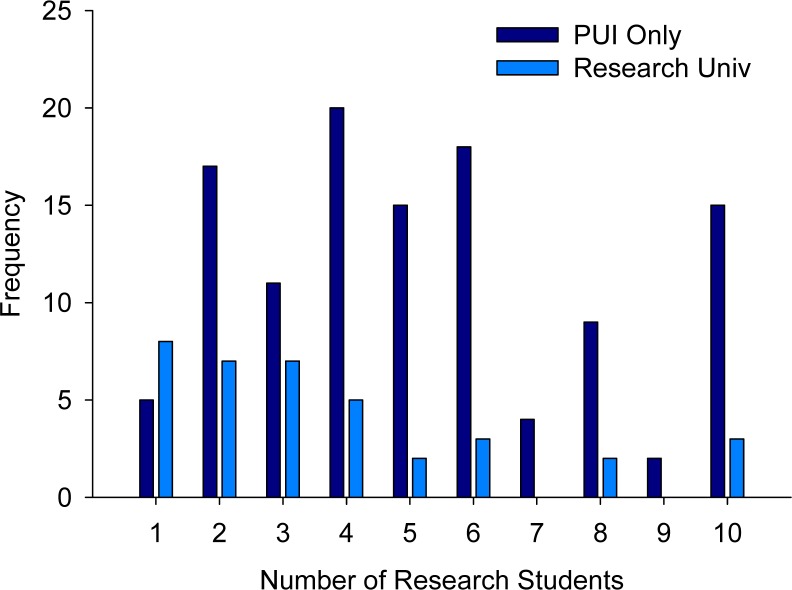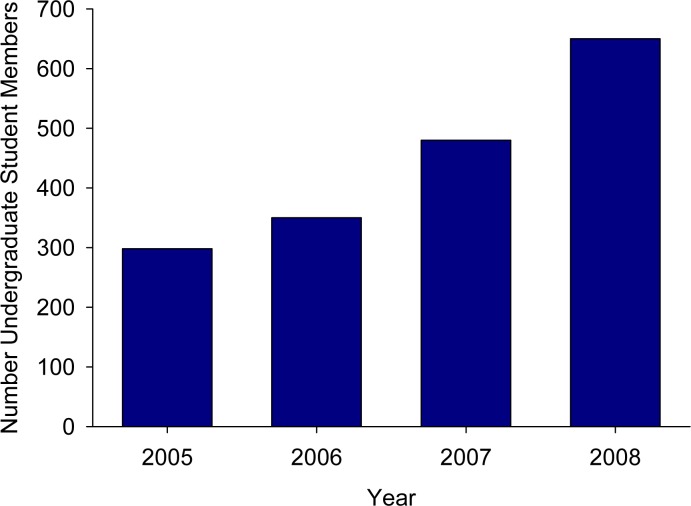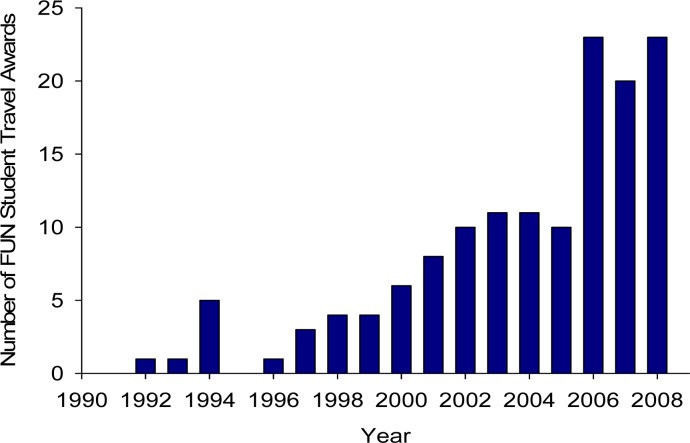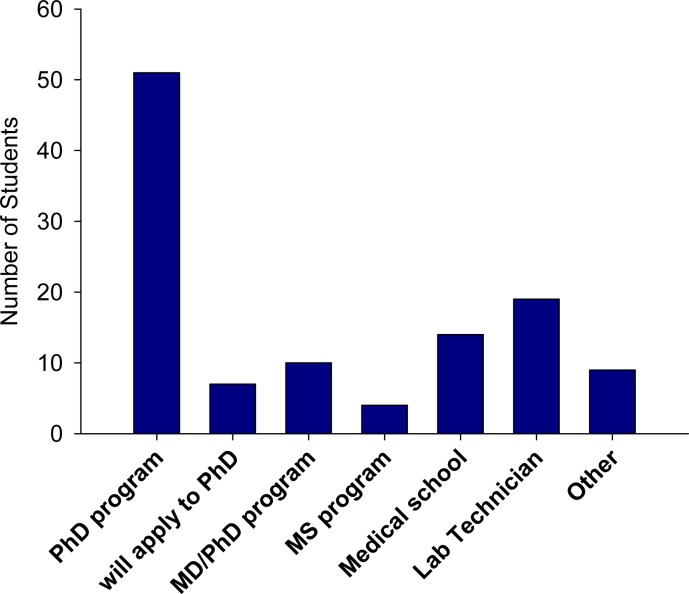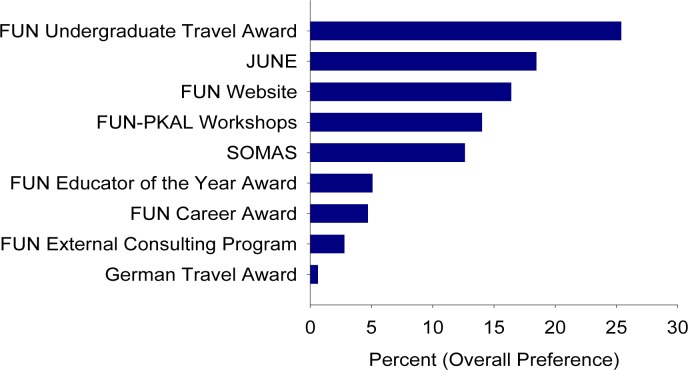Abstract
A survey was presented to members of the Faculty for Undergraduate Neuroscience (FUN) to get a better idea of how neuroscience research and education is being delivered at the undergraduate level. A total of 155 individuals completed the survey, with 118 coming from faculty at traditional PUIs (primarily undergraduate institutions) and 37 from faculty at doctoral-granting institutions. The survey covered a number of different areas; including types of neuroscience programs, number of neuroscience faculty at the institution, average course loads, average number of research students, and external support for research. Results from this survey indicate that the structure of neuroscience programs vary among institutions. Course loads for faculty at PUIs averaged four to six courses per year and the total number of undergraduate students supervised in research per faculty member averaged five (± 2.8) students per year. Faculty show high success with external funding, both at PUIs and research universities. Faculty ranked FUN programs devoted to supporting both students and faculty development highly. The results of this survey provide data that can be used to determine future directions and priorities for FUN.
Keywords: survey, faculty, undergraduate neuroscience, undergraduate research, teaching loads, external support
The Faculty for Undergraduate Neuroscience (FUN) has undergone significant growth in the past few years. Interest in the organization is growing, as can be seen by the increase in membership and the number of students participating in the FUN social and poster session, held at the Society for Neuroscience (SfN) meetings each year. Beginning in 1991 with the first FUN meeting of 67 participants (Ramirez and Normansell, 2003) to the FUN social in Chicago this fall which included over 100 student posters and approximately 500 attendees (2009, Chicago meeting). With this period of rapid growth, an obvious question has appeared; “Who are FUN faculty now?” This coincided with a growing need to more clearly define what the neuroscience faculty at undergraduate institutions are doing with regards to both teaching and research. This information would be useful to better inform and educate other organizations such as the Society for Neuroscience and the associated Committee of Neuroscience Departments and Programs (formerly the Association of Neuroscience Departments and Programs) and granting agencies about our activities. Some of the questions that needed to be addressed included information on teaching loads at undergraduate institutions, funding for research, numbers of research students, etc.
Although there is anecdotal information for many of these issues, the gathering of empirical data will hopefully help faculty who teach and do research with undergraduates to better define their activities to both administrators and fellow faculty at other institutions. In addition, this information will help FUN determine a course for the future as we seek to better define our priorities and try to find ways to strengthen the undergraduate teaching community.
Surveys of this sort are often utilized by organizations to help chart the course for future directions. The Association of Neuroscience Departments and Programs (ANDP, now the Committee for Neuroscience Departments and Programs within SfN) conducts biennial surveys of members (SfN.org). The Society for Neuroscience itself undertook an extensive member survey in 2007 and the results from that survey are currently the impetus for many new initiatives within the organization (Society for Neuroscience, FY2008 Annual Report). FUN has launched several new initiatives of its own in the last few years, such as the development of the Journal of Undergraduate Neuroscience Education (JUNE), a journal devoted to undergraduate education, faculty workshops, and new faculty development programs such as Support for Mentors and their Students (SOMAS) and the FUN equipment loan program, a new program that has emerged with the cooperation of corporate sponsors. As FUN moves in new directions, it is important to ask “Who are we?” and “What exactly do FUN faculty need?” The present survey is a first attempt to provide a clearer picture of who we are and what we do. This still leaves many unanswered questions and data to gather for the future, but we hope this will begin a dialog that will continue to advance undergraduate neuroscience education, and educators, for the future.
MATERIALS AND METHODS
Survey Design
Several members of the executive committee of FUN (Michael Kerchner, Bruce Johnson, Jean Hardwick, Chris Korey, Jennifer Yates, and Jeffrey Smith) developed the 20-minute survey which included forty-nine questions consisting of basic demographic questions, academic training, research and teaching activities, and interests and needs regarding FUN programs and activities. The survey was made available to all members of the organization (online at http://www.braininabox.org/survey/FUN) through the FUN list serve (approximately 500-600 members) on March 5th, 2009 and was active for approximately four weeks. All members of FUN were invited to participate through the FUN e-mail list and were offered a chance to win one of two iPODs as an incentive for completing the survey. A complete list of the survey questions is available as Supplemental Materials.
Data Analysis
At the completion of data collection, the data were tabulated and the appropriate descriptive statistics (frequencies, percentages, means, etc.) were computed for the majority of the questions. However, the questions regarding importance of the FUN programs and activities were analyzed using a statistical method known as a MaxDiff task (Marley and Louviere, 2005). In this task the respondents were shown a series of sets of items (seven sets of four items) and were asked to choose which of the four items were the most important and which would be the least important (within each set) and this task is repeated for each set of items. This method of determining importance is considered to be preferred over traditional Likert scales simply because respondents are much better prepared to determine extreme differences (best/worst) than attempting to determine an appropriate and reasonable Likert value (i.e. what is the difference between a 6 or a 7 on a 10-point scale) or a rank score value (what is the distance between a 3rd position and a 4th position in a rank order, Marley and Louviere, 2005). The MaxDiff task analysis employs an algorithm known as a Hierarchical Bayes model (Marley and Louviere, 2005), which provides insights into the sensitivity of perceptions of the importance of the FUN programs provided by the respondents of the survey.
Travel Award Data
Mentors of all past FUN Travel Award winners were contacted by email and asked to provide information on the student’s activities since the award. Responses were then divided into discrete categories of: (1) completed or currently enrolled in a PhD program, (2) completed or currently enrolled in an MD/PhD program, (3) currently applying to or with definite plans to apply to a PhD program, (4) completed or currently enrolled in a masters degree program within the sciences or teaching of science, (5) completed or currently enrolled in an MD or DO program, (6) currently or previously employed as a laboratory technician, and (7) none of the above. The final category included students whose current occupation was reported as unknown and students who had left the field of science. For some students, multiple categories applied (e.g. past laboratory technician and enrolled in a PhD program).
RESULTS
Faculty Profiles
One hundred fifty-five (155) completed surveys from FUN members at 128 different institutions were submitted. Of those, 118 faculty (76%) were currently employed at Primarily Undergraduate Institutions (PUIs), with the remainder of faculty at larger, doctoral-granting institutions. Faculty members were asked what type of institution they received their undergraduate degree from (Table 1). Of those individuals currently in positions at PUIs, 84% (n=99) also did their undergraduate work at a PUI, while 19% of faculty currently at a large research institution (n=7) did their undergraduate work at PUIs.
Table 1:
Undergraduate training for current FUN faculty
| Undergraduate Degree | Percent |
|---|---|
| PUI | 67% |
| Large Research Institution | 30% |
| Other | 3% |
Demographically, 54% of respondents were male, 46% were female, and 8% identified themselves as Hispanic or Latino. 89% of the respondents are currently in a tenure track appointment, with 60% (n=92) at the rank of Associate or Full Professor and 29% (n=45) at the rank of Assistant Professor. Those not in tenure-track positions listed themselves as retired, Visiting Assistant Professors, Lecturers or Senior Lecturers, Directors of Programs, or students. The majority of faculty list their primary departmental affiliation as either Biology (n=59) or Psychology (n=73). A smaller number (n=17) list Neuroscience as their department and an additional six individuals listed other departments (such as Chemistry and Physics).
Undergraduate Neuroscience Programs
Undergraduate neuroscience is delivered in many different formats. These range from formal neuroscience majors to a collection of neuroscience-related coursework. The survey asked individuals to indicate the different programs offered at their institutions. Some institutions offered formal majors in either Neuroscience or Interdisciplinary Neuroscience (Figure 1). For a very few programs, Neuroscience is a separate academic department, while for many programs the Neuroscience major represents a collaboration between Psychology and Biology. In other institutions, Neuroscience majors are more broadly based, with interdisciplinary components in Psychology, Biology, Chemistry, Computer Science, Mathematics, Philosophy, and more. However, for this analysis, we have combined all programs that offer an academic major within the field of Neuroscience. Similarly, minors were also offered in Neuroscience or Interdisciplinary Neuroscience and these were combined as Minors in Neuroscience. Finally, some institutions offered concentrations in Neuroscience (which usually entail fewer required courses than an official minor) or other specialized programs (such as certificates in Neuroscience, cognitive science programs, biopsychology, etc.). A significant number of institutions do not offer a formal neuroscience program (Figure 1), but do have courses and faculty with a strong focus in neuroscience.
Figure 1:
Types of neuroscience programs offered. Respondents indicated all neuroscience programs offered at their institutions. Majors include both Neuroscience majors and Interdisciplinary Neuroscience majors. Similarly, minors include both Neuroscience and Interdisciplinary Neuroscience. Neuroscience Concentrations (Conc) were also offered at some institutions and other programs (Other) that included Certificates in specific Neuroscience related areas or other Neuroscience-related programs. Finally, some institutions had no formal academic Neuroscience program (None). A total of 94 PUI institutions are represented and 34 doctoral-granting institutions.
The survey also asked how many faculty members at the institution routinely teach Neuroscience-related courses. This number varied widely, ranging from one to 100, with the most common response ranging between two to four faculty members (Figure 2). In addition, since we did not distinguish between neuroscience courses for majors or non-majors, this will include a broad range of course offerings. The larger numbers were more commonly seen at the larger, research institutions, but both PUIs and research universities appear to offer a range of neuroscience-related courses.
Figure 2:
Number of Faculty teaching neuroscience-related courses. The total number of faculty members, including the respondent, who teach neuroscience courses at their institution is indicated by the histogram. The mode for PUIs was two faculty members (with a mean of five faculty members), while the mode for doctoral-granting institutions was five (with a mean of 18 faculty members).
Faculty members were asked to indicate the number of undergraduate courses they normally teach during an academic year (Figure 3). Most individuals at PUIs teach four to six courses each year, with smaller course loads (one to two courses) more common at larger research institutions.
Figure 3:
Undergraduate course load per year for FUN faculty. Respondents indicated the average number of courses taught in an academic year. An average of four to six courses per year is the norm for most faculty at PUIs.
Undergraduate research experiences are a prime focus for FUN members. The survey also asked the average number of students involved in the individual faculty member’s research lab each year (Figure 4). The responses indicate that our members are providing a significant number of undergraduates with research opportunities, both at PUIs and larger, doctoral-granting institutions. However, the larger numbers of student researchers were found most often at PUIs.
Figure 4:
Average number of undergraduate research students per year. The number of undergraduates involved in active research in FUN faculty laboratories in a year ranged from 1-10, with an average of 5 ± 2.8 students/year.
Undergraduate Research
The large number of students involved in research at the undergraduate level has led to an increase in the number of students attending and presenting at scientific conferences. In 2005 the Society for Neuroscience added a new membership category for undergraduates with reduced registration fees for the annual meeting. In addition, many more undergraduates register and attend the meeting as student-nonmembers. The Society does not keep records on non-member registrations, but we were able to obtain information on the number of undergraduate student members attending the annual meeting for the last four years (Figure 5).
Figure 5:
Number of undergraduate student members attending the SfN meetings. SfN provided numbers of undergraduate student member registrants for the last four years, since the membership category was introduced. The number of nonmember student registrants is not currently tracked by the society.
As increased numbers of undergraduates are attending conferences such as SfN, many are looking for mechanisms to cover the costs associated with attending the annual meeting. FUN has been providing travel awards for undergraduates to help fund student attendance at the Society for Neuroscience meetings since 1992. The number of awards has increased dramatically over the past few years (Figure 6) in response to increased demand and a rise in corporate sponsorship of awards.
Figure 6:
Number of FUN student travel awards. The first FUN student travel award was given in 1992. Since that time, the number of awards has increased substantially, with over 20 awards given in each of the last three years. (Note: No record of awards given in 1995)
The value of this travel award program can be seen in the outcomes of the students who receive these awards. Mentors from past travel award recipients were contacted and asked to provide information on students from their lab who had received a FUN travel award. Of the 140 awards given since 1992, we were able to gather information on 106 of the awardees (75%). Figure 7 summarized this information, with approximately 64% of travel award winners currently enrolled in, or planning to enroll in PhD or MD/PhD programs.
Figure 7:
Outcomes of FUN travel award winners. Mentors of former student travel award winners were asked to indicate the outcome of the students. Results were combined into the general categories indicated. For “other,” the student either entered another field or his/her current occupation is unknown. Of the 140 awards given, outcomes for 106 students are shown here. Some students appear in multiple categories (such as Lab Technician and PhD program), depending on their activities since graduation.
External Support for Research
Maintaining an active neuroscience research program that involves undergraduates often requires resources beyond what a faculty member’s institution can provide. Individuals were asked about their current and past history with external funding for research. Of the 155 individuals who completed the survey, 49% currently have some form of external funding. When considering only those faculty at PUIs, 42% currently have external funding. When asked about external funding overall, 78% of respondents have had some form of external funding for their research or teaching efforts. Funding percentages were higher for faculty at research universities, but faculty at PUIs also demonstrated significant funding success with government agencies and other sources. A comparison of funding for all faculty, along with funding sources, is shown in Tables 2 and 3.
Table 2:
Current external funding percentages by funding source.
| NIH | NSF | Other | Total | |
|---|---|---|---|---|
| All FUN Faculty | 27% | 17% | 18% | 49% |
| PUI Faculty only | 21% | 15% | 18% | 42% |
| Research University Faculty only | 46% | 24% | 19% | 70% |
Table 3:
External funding success overall. A total of 155 faculty responded regarding current and past external funding; 118 faculty from PUIs and 37 from research universities. Funding sources included National Institutes of Health (NIH), National Science Foundation (NSF), and other sources, such as private foundations and pharmaceutical companies.
| NIH | NSF | Other | Total | |
|---|---|---|---|---|
| All FUN Faculty | 46% | 42% | 38% | 78% |
| PUI Faculty only | 42% | 44% | 39% | 76% |
| Research University Faculty only | 59% | 32% | 35% | 84% |
Faculty were also asked about start-up funding. Although the majority of faculty in tenure-track positions did receive some start-up funds, the amounts varied widely. The mean start-up funds reported for faculty at PUIs was approximately $40,000 (n=118), with values ranging from $1,000 to $100,000 (standard deviation of ± $41,000). The mean for faculty at doctoral-granting institutions was approximately $120,000 (n=23), with amounts ranging from $1,000 to $600,000 (standard deviation of ± $180,000). Clearly the variability within these data for both groups was extremely high and did not control for the year funds were granted, which ranged over many years, even decades in some cases. If only the start-up funds for PUI faculty members at the rank of Assistant Professor in a tenure-track line were considered, the mean was $48,000 (n=32, with a standard deviation of ± $40,000), whereas the mean for Assistant Professors at doctoral institutions was $278,000 (n=8, with a standard deviation of $299,000).
FUN-sponsored Programs
During the survey, individuals were asked a series of discrete choice questions to determine how people felt about different current FUN initiatives. Specially, they were asked about the Student Travel Awards, JUNE, the FUN website, FUN-PKAL workshops, SOMAS, the Educator and Career Awards, the FUN External Consulting program, and the German Travel Award program. The programs that the membership most often chose as important were (in rank order, Figure 8) the Student Travel Awards, JUNE, and the FUN website as the top three programs that the organization provides for its membership. The German Travel Award and the FUN External Consulting Program were not valued as highly as the other programs.
Figure 8:
Percent (Overall Preference) of program support by the Faculty for Undergraduate Neuroscience. The membership clearly preferred programs associated with student development which had the broadest reach across the undergraduate population. In addition, faculty growth and development programs were also deemed important. Award programs that have limited reach (impact on few) were considered to be less important.
DISCUSSION
The data from the current study indicates that opportunities for student-centered neuroscience education and research exist at the undergraduate level. These opportunities provide an environment that allows for students to explore the discipline from a basic introductory level to an intense immersion into the discipline itself. The opportunities do vary from institution to institution and it appears that these differences are based on the existence of specific programs and the number of faculty (resources) responsible for teaching at any one institution. Regardless of the institutions’ support, it is clear that the respondents (the membership of FUN) are committed to providing programs that include research opportunities for undergraduates. The consequence of these enhanced research opportunities can be seen in the increases in the number of students attending meetings such as the Society for Neuroscience, and in the number of students who receive FUN student travel awards that continue in research.
The Society for Neuroscience only maintains records on the number of undergraduate student members attending the meeting. Many undergraduates attend the meeting as nonmembers, perhaps as many as two to three times the number of registered members, based on past attendances from the authors’ institutions and those from other FUN members (personal communication). This suggests that the total number of undergraduates attending the 2008 SfN meeting may have been more than 2000. Not all of these students are attending with mentors who are members of FUN, although attendance at the annual FUN Undergraduate Poster Session has dramatically increased over the past several years and is now estimated to approach 400-500 people. Clearly, undergraduate research in neuroscience is growing and many more of these students are attending professional conferences, such as SfN, to present their work and attend talks and presentations by experts in the field. The efforts of FUN to help facilitate their attendance and to provide a forum for them to present their research is clearly a high priority among our members. In addition, the development of regional Neuroscience meetings, such as NEURON (Northeast), SYNAPSE (Southeast), and MIDBRAIN (Midwest) provide additional opportunities for undergraduates and faculty to present research and exchange ideas.
Current estimates of the percentage of students who continue in graduate school in the sciences are in the range of 2-6% (National Center for Education Statistics, National Science Foundation, 2006). The number appears to be higher for students from PUIs, such as was shown in the study on the “Oberlin 50” (National Science Foundation, 2008), which indicates that as many as 10-15% of students from these select institutions are continuing in graduate programs in science. The fact that roughly 64% of former FUN student travel award winners have gone on to, or are planning to continue in PhD programs, indicates that the significant research opportunities provided to these students had a profound impact on their ultimate career choices. Many of the faculty responses about their former travel award students spoke of the student’s indecision regarding postgraduate plans – but that attendance at SfN convinced these students to pursue graduate school. This is consistent with other studies that indicate that undergraduate research experiences have a significant impact on a student’s decision to continue in graduate programs (Lopatto, 2004; Russell et al., 2007).
In addition to the focus on students, the survey also highlighted the importance of supporting faculty development. FUN faculty have significant teaching responsibilities (as indicated by course loads). Many faculty are working at institutions with few neuroscience colleagues, which limits opportunities for collaborative teaching and/or research. Programs such as the FUN workshops provide a much-needed opportunity for faculty to network and share strategies for both teaching and research. In addition, expanding the networking and resource sharing via the FUN website can also help faculty with their professional development.
There is often a misconception among doctoral programs in neuroscience that research at PUIs is less rigorous or less technical than research at large universities. Examination of the external funding histories of FUN faculty, most of whom are located at PUIs, indicates that faculty are involved in rigorous, productive, and significant research. With so many faculty able to obtain funding from both NIH and NSF, even with this highly competitive funding environment, demonstrates that experts value the research going on at all types of institutions; both small and large schools. The expansion of the NIH Academic Research Enhancement Award (AREA) program over the past decade and the continuation of programs such as NSF’s Research at Undergraduate Institutions (RUI) programs provide mechanisms for faculty to maintain vigorous research initiatives that involve undergraduates at PUIs. Both of these grant programs specifically target undergraduate institutions and programs that involve significant undergraduate involvement. The SOMAS program, initiated by Julio Ramirez in 2005, has provided a mechanism to help young faculty develop their research program and mentor them in the grants writing process (Ramirez and Tonidandel, 2009).
An analysis of the average start-up funds for FUN faculty members indicates that there is a wide range of start-up funding levels. Although the mean for faculty at PUIs was ∼$40,000, the high degree of variation indicates that it is not possible to draw any significant conclusions from these data. Although it is clear that higher startup packages are provided at doctoral granting institutions, the variability here was also very high. Clearly, the wide range of resources available to individual institutions results in wide variations in startup funding levels.
One fact which does emerge from this survey is the current lack of diversity within the FUN membership. To better reflect the diversity within the students we teach, FUN may want to consider mechanisms to reach out to a more diverse faculty for membership, as well as increasing FUN’s activities at institutions with diverse student bodies.
The rankings of various FUN programs clearly illustrates that FUN faculty place the highest value on programs that support undergraduate attendance at SfN and programs that most directly help with faculty development of both teaching and research. Thus, JUNE as a major resource for teaching-related activities and the FUN workshops were ranked highly. Similarly, the SOMAS program also has strong faculty support. Some of the less familiar programs, or newer initiatives were not ranked as highly. The German Travel Award is given to a student at the poster social to allow them to travel to Germany and visit graduate programs. Given the limited impact of this program (one student each year), it is not surprising that it was not ranked highly. However, this program does not require financial support from FUN and students continue to apply for consideration each year.
Similarly, the various awards presented by FUN (Educator of the Year, Career Award and Lifetime Award) also have limited impact among the general membership. However, recognizing the efforts of our members and others who contribute to the success of FUN helps to highlight important advances within the undergraduate neuroscience community. One of the newest FUN initiatives, the FUN External Consulting Program, was started at the 2008 Macalester FUN workshop. It is still too early to evaluate the efficacy of this program, but it does provide a resource for those departments or programs seeking external reviews or outside advice.
Overall, the results of this survey confirm that neuroscience is thriving at the undergraduate level. Research opportunities for undergraduates continue to be of primary importance to FUN members and their successes in this endeavor are clear. This survey also confirms the importance of the organization in providing a mechanism to support both faculty and their students. The results from this survey can now be utilized by the leadership and members of FUN to chart new initiatives and programs, based on a more complete understanding of the priorities and strengths within the FUN membership.
Acknowledgments
The authors would like to thank Michael Kerchner for his work on the initial development of the survey and Bruce Johnson for critical review of the manuscript and many helpful discussions during the analysis of the survey.
REFERENCES
- Lopatto D. Survey of Undergraduate Research Experiences (SURE): first findings. Cell Biology Education. 2004;3:270–277. doi: 10.1187/cbe.04-07-0045. [DOI] [PMC free article] [PubMed] [Google Scholar]
- Marley AAJ, Louviere JJ. Some probabilistic models of best, worst, and best-worst choices. J Math Psychol. 2005;49:464–480. [Google Scholar]
- National Center for Educational Statistics Advanced degree completion among bachelor’s degree recipients. 2006. http://nces.ed.gov/programs/coe/2006/section3/indicator32.asp#info.
- National Science Foundation Science Resource Statistics 2008. Baccalaureate origins of S&E doctorate recipients. http://www.nsf.gov/statistics/infbrief/nsf08311/nsf08311.pdf.
- Ramirez JJ, Normansell L. 2003. A decade of FUN: The first ten years of the Faculty for Undergraduate Neuroscience. Essay for Project Kaleidoscope, Neuroscience Network, August 2003: www.funfaculty.org/drupal/sites/funfaculty.org/files/ramirez%202003_0.pdf.
- Ramirez JJ, Tonidandel S. SOMAS-URM: The evolution of a mentoring and summer research program. J Undergrad Neurosci Ed. 2009;8:A69–A72. [PMC free article] [PubMed] [Google Scholar]
- Russell SH, Hancock MP, McCullough J. The pipeline. Benefits of undergraduate research experiences. Science. 2007;316:548–549. doi: 10.1126/science.1140384. [DOI] [PubMed] [Google Scholar]
- Society for Neuroscience FY2008 Annual Report http://www.sfn.org/skins/main/pdf/annual_report/fy2008/community.pdf.
Associated Data
This section collects any data citations, data availability statements, or supplementary materials included in this article.



